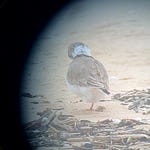“The little song sparrow, which is so appropriately named from his own sweet lay, is a bird of promise and hope; for in late February or early March while the clouds are still gray and the air has no touch of spring, he sings his courageous song of perfect trust and good cheer.” —Angelia Kumlien Main, Bird Companions, 1925
The Song Sparrow is one of the only birds that is singing on cold spring days. Through much of the year, there’s nothing particularly exciting about finding a Song Sparrow. But seeing and hearing one in March is still a novelty. I’ve heard the song described as somewhat dull and repetitive, but that’s never been the case for me. It’s spritely and lilting and highly variable.
So to is the Song Sparrow as a species. For us in the American Midwest, this bird is streaked all over. Crown, neck, breast, flanks, upper parts—all streaked. But in the Desert Southwest, the birds are pale, while those in the Pacific Northwest are dark and heavily streaked. As one source shares: Song Sparrows of Alaska’s Aleutian Islands chain are even darker, and they’re huge: one-third longer than the eastern birds, and weighing twice as much.
To find a Song Sparrow, listen for one in gardens, orchards, roadsides, and meadows. They often prefer moist land near water.
As Ms. Main writes, “in his song he will tell you that it is good to live and to be here.”









